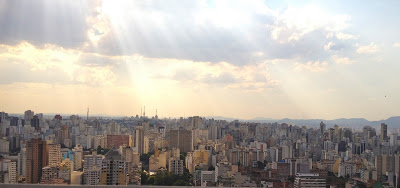If you ever find yourself São Paulo here are my suggestions – What to do and where to go.Street food
each district have at least one or more markets happening during the week. They are regulated by the town hall. The street markets are great sources of jobs and distribution of production of fresh fruits and vegetables, as well as the meat and the fish trade.
Feira em Sao Paulo
 |
| cart displaying all sorts of coconut sweets for sale (above)
Pastel & sugarcane juice (left) and Tapioca (right) traditional street food at street markets: Mercado Municipal: |
Typical juice bar – all fresh produce (left) and pão de queijo and Guarana (right)


Food suggestions:
Comida for kilo is everywhere in Brazil –
Usually a extensive buffet of hot, cold foods and deserts.
Your plate is weighted in and you pay per kilo.
Below churrascaria, Fogo de Chão:
Two fruits to try while in Brazil:
Avenida Paulista – the heart of financial, cultural and business centre in São Paulo, the 2.8 kilometre is home to an extensive shopping area and to Latin America’s most comprehensive fine-art museum – MASP.
The station is part of the metropolitan rail system. It houses the Museum of the Portuguese Language, established in 2006. The station was built with materials brought from UK. The station was designed and produced by Walter Macfarlane & Co. Saracen Foundry Glasgow.
Place to stay, eat and drink:
InterContinental Sao Paulo (below)
Located at Jardins district – Upmarket restaurants and shops, near Av. Paulista
Great bar at Unique hotel, the Skye Bar and view over Sao Paulo (below), designed by Ruy Ohtake
Av. Brigadeiro Luis Antonio, 4700, Jardim Paulista, São Paulo
Most famous junction of city : Av Ipiranga x Av. Sao Joao – a bit of a touristic point, Bar Brahma. Bar Brahma has been the meeting place of choice for intellectuals, musicians and theatre-goers since 1948. The bar bore witness to key of events in São Paulo’s history, from inflamed discussions about the political repression of the 1960s to the bourgeoning of bohemian samba circles. Great for sampling some of Brazil’s famous nibbles like pao de queijo, coxinha, picanha na brasa etc. The menu is extensive and suggestion is to wash all down with a delicious caipirinha or chop (light coloured beer) served below freezing.
Terraço Itália Restaurant
Panoranic view of São Paulo from 41st Floor from Terraco Italia Bar and Restaurant
free between 3-4pm Monday-Friday – check before you go.

More sightseeing…
Football fans:
Estádio do Pacaembu
Praca Charles Miller, S/N, Sao Paulo
    |
Postbox (right)
 |
| above traffic lights entertainment |
View of the Sé square from the Cathedral
City center architecture
 |
| Patio do Colegio – this is where Sao Paulo was founded in 1554, today is part of the city center. |
 |
| Court of Justice |
More suggestions: São Paulo off the beaten track
Where to stay in São Paulo?
More pictures: Flickr and Facebook













































I wish I had a chance to go to San Paolo tomorrow! I would be happily ready to leave, what time is the flight? 🙂
Sao Paulo is a very vibrant city. Unfortunately, not many people know what to do and where to go. Hope this small guide is of use.
What a great post! Sao Paulo looks like such a great city! I wish I could just hop on a plane! 🙂